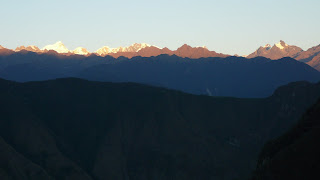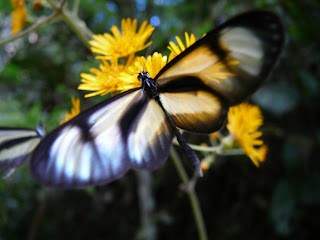
If at first you thought you had to get up at 3:15 a.m., getting up at 3:45 wasn´t so bad. And we were sipping espresso by 4:30.

It was a little surprising that there was espresso in Aguas Calientes (the tiny but growing-before-your-eyes town at the base of Machu Picchu), and it was very surprising that it was available 24 hours a day. But it will not be surprising to you at all that we started our hike with it.

Time check, post-espresso
Powered by the bean, we donned our headlamps and followed a small trail of flashlights along the Urubamba river, crossed the bridge, and plunged into the dark forest to spend the next hour or so huffing and puffing up the switchbacks. All told the trail gains about 3,000 feet. We must have been pretty fast (a combination of caffeine and several weeks at high altitude), as we passed many people along the way.
I had a momentary thought, sweatily stepping onto to the umpteenth knee-height stone stair, that perhaps we were first! But it was not to be. We burst out of the forest and into a waiting area behind several large groups... their guides probably really made them get up at 3:15.
What was the hurry? Good question. Partly, I guess, to see dawn at Machu Picchu. Partly to see Machu Picchu with fewer people. See below for both.

Machu Picchu with no people, really, and Huayna Picchu looming in the background
And partly because you can climb Huayna Picchu, the peak behind the iconic images of Machu Picchu, but to do that, you have to get there really early, because they limit the number of people they allow to go up.


Sun beginning to hit the Vilcabamba range
Oh, sure, you can take a bus, at the sloth-like hour of 5:30. But we had already opted not to do the Inca Trail or a similar trek, largely for cost reasons. So we wanted to get some hiking in. Especially if by hiking we could get there first.

Wearing all the layers we´d shed on the hike up: cold but happy


As we wandered through the ruins on our way to Huayna Picchu, we got an extra treat. Some people were talking about chinchillas, and they pointed one out in the rocks above.
Only it wasn´t a chinchilla.

Peering out from behind the greenery
It was a vizcacha! We´d been wanting to see this animal ever since we were in Patagonia. Actually, ever since before we left the US, when we saw a picture of one in a catalog that was so absurd we had to put it on the fridge. And then we saw it in a nature special. But we never saw any in Patagonia or in the altiplano of Bolivia. So this was a very exciting moment.
It was very still, so it may have been warming up. We learned from the nature special that vizcachas are a little like butterflies, or cold-blooded animals... they go into a state of deep torpor every night and can´t really move in the morning until the sun hits them, when they can suddenly bound off.
Later, I realized that the little brown tic-tac like droppings in many niches of the ruins were probably left by vizcachas. Machu Picchu may well be crawling with these rabbit-like critters. Later we also got an even better sighting.

But meanwhile, we were off to Huayna Picchu when the trail opened at 7.

It´s as steep as it looks but fortunately not as impregnable

Wildlife along the way

Oh boy! More stairs!
The climb to the top was another 1,000 feet or so, but the view was well worth it.

We found ourselves a little eyrie to perch on, had our second breakfast, and spent about an hour in the sunshine.

Eventually we figured we´d better get back and explore the site itself.

Plant life along the way: this looks to me an awful lot like uluhe, a native Hawaiian fern ... I think I also saw it in Southeast Asia... I believe it´s known to occur in all these places, but it was so strange to see it here!
After a bit of botanizing, we wandered among the ruins.

Trapezoidal windows: the Inca built their buildings and windows using this shape for greater stability -- this and other Inca sites have survived many earthquakes that have caused colonial walls to crumble

But gravity, entropy, etc. have taken their toll... rocks slipping above a massive altar stone

Rings made of stone: roof materials were tied to these rings atop the walls

More trapezoids: the door and the cleverly shaped rock above it

The Inca went to what looks to me like an enormous amount of trouble to sometimes carve stones to fit into other stones, jigsaw-like, rather than carving all the stones into squares

This may be more clear: see above where the same stone zigs and zags several times to fit with the stones above it

Intihuatana, often called the ¨hitching post of the sun¨: just a few days ago, on the winter solstice, the sun rose and set directly in line with this. These exist in many old Inca ruins but were usually destroyed by the Spanish to combat ¨pagan¨ sun worship -- fortunately the Spanish never found this site
From what I´ve read, Machu Picchu may have been a kind of ¨stately pleasure dome¨ for Inca nobility, where perhaps 500 - 1,000 people lived at any one time. It may not have been entirely religious, but it was a site for rituals, with a temple and various sacred carved rocks aligned with the sun and with mountains, which were objects of veneration for the Inca.
Machu Picchu was built so as to maximize sun exposure. The buildings and the stepped terraces minimize shade and so the Inca were able to grow many different plants here, and also stay warm even at about 8,000 feet in elevation.
They had an ingenious irrigation system which is still visible today; water moves through twists and turns in stone, pouring from level to level throughout the site. I don´t know where the water comes from now, if it still comes from snow melt or is somehow piped in using modern technology. But the sound of the trickling water in the heat of the day, coupled with the extraordinary views on all sides, does evoke Shangri La.

A rock carved to follow the lines of the mountain beyond
We decided on another short walk, this time out to the ¨Inca drawbridge.¨ Fortunately the route was shady, as by now the sun was blazing and it was hard to remember my early-morning wish for gloves and a scarf.

Along the way there were more spectacular views of the snow-covered Vilcabamba mountain range, and some closer views of trees covered in epiphytes. I had been surprised by the jungle-like surroundings of Machu Picchu -- in fact, this was one of my favorite things about the site. Suddenly, after weeks of high dry altiplano surroundings, we were in humid cloud forest, with ferns and orchids and tropical flora and fauna.

Red bromeliads perched up high

Look closely at the right wing of this butterfly: you can actually see through to the petals of the flower below

Fortunately, our walk didn´t involve a great deal of elevation change, because by now we were a little tired. It did, however, offer a pretty daredevil experience: we rounded an abrupt turn in the trail and saw the bridge below us: a few logs perched above a chasm.

I was wondering whether I was really up for crossing it when we saw (to some relief on my part) that you were not actually allowed to go all the way to the drawbridge. Instead, we stopped and had lunch with a view.
The bridge was ingenious, though. Restored to beautiful condition, it made clear that the Inca could easily pull back the logs and effectively close off their mountain fastness. With a long cliff above and below, it was hard to see where any trail at all could have gone. Eventually we saw a line of green bushes crossing a sheer rock face beyond the bridge; this area has not been restored and looks so precarious I think it´s unlikely that it will be.
I already was in awe of the aerobic capacity of the Inca -- who though shorter than Marty and I probably skipped lightly up steps that were thigh-high on them -- and now I also admire their heads for heights.
Also, they were very good at choosing views. When we came back from the Inca drawbridge -- along the original entrance path, presumably -- even after we´d been wandering all over the site, the vista was breathtaking.

Later in the afternoon, we descended the trail to Aguas Calientes, where we fully intended to go visit the hot springs. Instead, after returning to our hotel 12 hours after leaving it, we fell accidentally asleep, waking only for a late dinner. Perhaps that had been enough for one day.

Great photos and post! I wonder if Bill is part vizcacha? I'm such a terrible sleeper and like the vizcacha he too goes into a state of deep torpor every night and can´t really move in the morning until the sun hits him...
ReplyDeletexo,
Rosey
Ah, perhaps he´s found his totem animal.
ReplyDeleteThat first photo is so strange. It looke like The llama (alpaca?) is photoshopped onto the landscape. Is it the quality of the air that makes it look that way?
ReplyDeleteI, too, had coffee at 4:30 this morning. Couldn't sleep. Went to 24-hour coffee shop to work. Parallel lives.
The terraces are really amazing, btw.
Love hearing about your trip. Beautiful photos and intriguing descriptions of your travels!
ReplyDeleteThank you, Carla!
ReplyDeleteI love the vizcacha (shocker...right?)! I love this whole post, except the part about the scary drawbridge. Nice job on conveying the scariness... ACK!
ReplyDeleteI have to ask: were you really suprised that there was coffee available 24/7 in a place called Aguas Calientes? I mean, really, what are they to do with the hot water. :)
Good point about Aguas Calientes, Cy. Clearly the highest and best use!
ReplyDelete